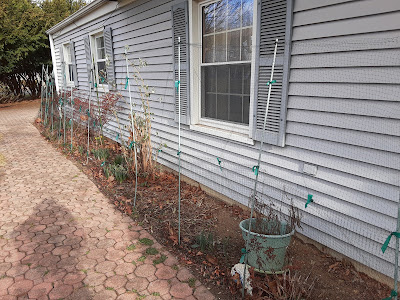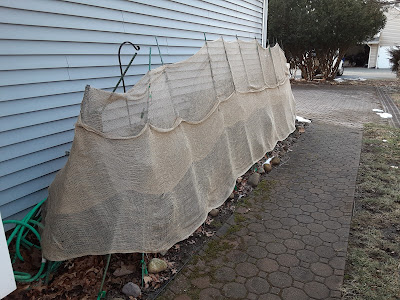My brother-in-law lives in a rural part of New Hampshire. When we visit in winter his feeders draw a number of birds. Winter can be harsh up there, climate change notwithstanding. Sometimes the feeders draw something unusual - common redpolls or a flock of wild turkeys, for instance.
 |
| (Margo D. Beller) |
Recently he announced the feeders had drawn something really unusual, at least to his yard - deer.
Welcome to my world.
In the past, hunting or natural predators have been very efficient in keeping down the deer population in his area. But now there are more homes being built on his road, and those neat parcels of lawn are very enticing for deer. Hunting season is apparently no longer enough up there.
All this, including hunting in restricted areas, has been going on in my suburban New Jersey neighborhood for decades. I've learned the hard way what happens when you grow plants that are not only attractive to you but to wildlife.
First it was the rabbits that nibbled at the asters. I put in a small fence that discouraged them. But it did nothing to stop the deer eating the asters or the euonymous shrubs or the lilies or the sedums. So I put in metal fence posts and hung deer netting. The fence posts would not stay in the ground so eventually they were replaced by thin, plastic-coated metal posts I could more easily hammer in, and on which I tied the netting.
 |
| Protecting the evergreen euonymous (Margo D. Beller) |
Then I learned a hungry deer that was desperate enough would grab the netting with its teeth or use the strength of its hoof to rip a big hole. At first I used burlap to cover the netting on two front plots in winter, but the flapping and tearing caused by the wind had a neighbor complaining. Now I double a piece of netting to make it that much thicker, and I cut back the evergreen euonymous plants as winter approaches to make them harder to reach.
Like my brother-in-law I learned a deer will knock feeders around and eat the spilled seeds. One morning I saw an 8-point buck eating from the house feeder. Not wanting to be gored I banged on the enclosed porch's glass. It looked at me and ambled away. Another reason to take in the feeders at night. (I'd been taking the feeders in at night ever since the first bear attack, except when we've had heavy snow.)
I learned a fawn could get behind the netting from around the corner if I didn't block the space with folded metal fencing. I learned there are plants deer are less likely to eat, though a hungry deer will always take a bite out of something (such as a canna leaf or a hot pepper) and then learn not to eat it again. (Of course, if enough deer take a bite, you have a dead plant.)
 |
| (Margo D. Beller) |
If I had known about deer over 25 years ago when I put in the plants what I have since learned, my garden would look very different. No azaleas and more daffodils, for instance. More ornamental grasses, fewer sedum.
With Spring coming on I am already dreading the annual hassle of pulling the netting down so I can position myself as close as possible and then lean over the net to remove leaves or stray locust pods and get the beds ready for the season. Every few years I have to pull out the posts and replace the netting. (Last year I did this with the two front beds in a marathon session. Once netting comes down it can't be left that way because of the deer threat.)
 |
| Backyard burlap protecting yew plants I learned are particularly attractive to deer. The backyard neighbor doesn't seem bothered by the burlap. (Margo D. Beller) |
Every year I say to hell with it, I'm taking down all this damned fencing. Then a herd of two to eight deer passes through and I remember why I struggle with this damned fencing.
My brother-in-law doesn't have to worry about this in his rural Eden, at least not yet. For now he'll be taking the feeders in at night, until the bears come out of their dens and he stops feeding the birds for the season anyway.

No comments:
Post a Comment